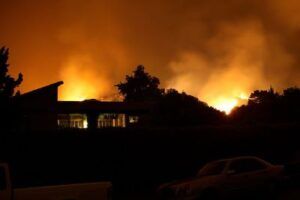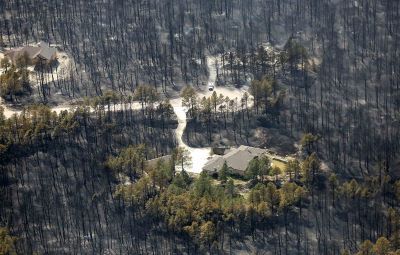As wildfires rage across the American West, hurricanes intensify in the Southeast, and insurance markets tighten nationwide, the demand for fire-resilient, climate-ready buildings is no longer theoretical—it’s urgent. What was once seen as rare or exceptional is now becoming the new norm, both in the U.S. and globally. In the metal construction sector, leaders are taking note and taking action.
In a recent METALCON Online webinar, a high-caliber panel of experts came together to unpack the intersection of building science, climate policy, material innovation and insurance economics.
With METALCON 2025 on the horizon, the session was moderated by Frank A. Stasiowski, FAIA, CEO and founder of METALCON and PSMJ Resources. He was joined by Alan Scott, FAIA, director of sustainability at Intertek; Dick Davis, former fire engineer and technical specialist with FM Global; Brian Partyka, vice president of business development of Carlisle Companies; and Anoush Brangaccio, senior policy advisor at the Florida Office of Insurance Regulation.
From testing standards and code lag to community planning and insurance incentives, the discussion emphasized one central theme: metal has an integral role to play in the future of resilient construction.
Codes Are Catching Up—Too Slowly
Recent catastrophic fires and storms have revealed painful shortcomings in how the construction industry approaches resilience. Many buildings, especially older ones, were not designed to withstand the hazards resulting from today’s extreme climate events. While building codes are evolving, our panelists were unanimous in a critical point: they’re not keeping pace with the climate.
“The fact that there has been such disaster, it shows you cannot rely on the existing codes and standards,” said Dick Davis. “We have to look closely at the science and figure out what materials to use whether it is residential, commercial or industrial construction. Alan Scott added, “Recognize these hazardous events can happen anywhere. What happened in the past is not necessarily indicative of what will happen in future occurrences, so assessment is required.” Scott shared a sobering example of a California apartment building that highlighted the flaws in current fire risk mapping. Depending on which map you used, the building was shown in both a low-risk and high-risk zone—yet it ultimately burned to the ground in the recent wildfires. “Perhaps some preassessment to determine risks might have prompted some action to reduce those before hazard happened.”
Anoush Brangaccio explained the structural delays in the code-update process. “The building code is updated every three years,” she said, adding that some states lag even further. Not all states have uniform building codes, and if they don’t, it’s time they consider implementing one. Davis confirmed that reality: “I’ve seen situations where some states were still using the 2003 code when the 2015 code came out. That’s how backlogged it can get. And people need to remember that code requirements are minimum requirements. There’s nothing wrong with exceeding those requirements.”
Climate Is the Driver—and It’s Changing the Game
“I would just add that climate change is really the key driver behind most of these tragedies,” said Brian Partyka, “including stronger storms, heavier rainfall, more intense winds, and worsening droughts in California.”
Frank Stasiowski asked whether these events are catalyzing innovation or constraining it. “It spawns innovation,” Partyka responded. “We’ve stopped talking about a metal roof and [started saying], ‘Let’s talk about a fire-resistant underlayment product with a two-hour burn rate.’”
Partyka pointed to multiple product innovations in development: “We have a two-hour fire-rated wall insulation product that’s made of denim jeans, old, recycled denim jeans. It’s pretty awesome to watch the innovation that happens as a result.”
Metal’s Edge in a Hazard-Rich World
While no single material can solve every risk, metal stands out as one of the most effective front-line defenses—especially in fire-prone regions.
“Metal roofing would be a wonderful solution for areas that are prone to fire, wind and hail,” said Partyka. “Will they dent in hail? For sure, they’ll dent in hail…but the metal roof is going to have a Class A fire rating.”
He noted that organizations like the Insurance Institute for Business & Home Safety (IBHS) are pushing for more rigorous standards. “There’s a wildfire prepared neighborhood program by IBHS… and metal roofs are mentioned in that as a non-combustible Class A fire rated [product].”
But Partyka was careful not to oversell. “It’s not the end-all be-all…I don’t want to say this is the cure, and everybody should have a metal roof. I think it will help to eliminate some of the possibilities of ignition.”
Davis explained why not all metals perform equally in fire scenarios: “The melting temperature of aluminum is about 900 to 1,200 degrees Fahrenheit; copper is approximately 2,000 degrees; and steel is north at 2,600 degrees. Actual flame temperatures vary from 1,000 to 2,000 degrees.”
Testing, Certification, and Insurance: The Approval Matrix
“I think one of the successes in Florida has been their Florida Product Approvals system,” said Partyka. “You don’t have that code approval or that number, then guess what? You’re not going to be able to sell your products in the state of Florida.”
Davis emphasized the importance of rigorous testing. “There is a requirement pretty much everywhere for testing exterior exposure, fire exposure roof covers…that test is ASTM E108 or UL790.” He warned that not all materials are held to the same standard: “Codes have more or less grandfathered or waived the tests for certain types of materials…but aluminum is not grandfathered.”
Scott added, “Generally, architects aren’t aware enough about resilience issues…there needs to be greater awareness among the design community about all the different standards and tests.”
From the insurance side, Brangaccio detailed how Florida incentivizes high-performance materials: “We do offer discounts…relating to the roof, roof coverings, connections.” She added, “We’ve even broken out metal roofs, and…metal roofs compared to some of the other roofs would get a higher credit for wind.”
Holistic Design and System Thinking
The consensus was clear: resilience isn’t about one product, one material or one code update—it’s about the system.
“Whether we’re talking about fire resistance or hurricanes or floods,” said Scott, “designing buildings that have overall greater sustainability like designing for passive house type standards…means you’re both resilient against those hazard events and…have a building that’s less expensive to operate, uses lower utilities and has a lower carbon emission.”
Davis drove the point home with a stark reminder: “If that fire gets inside the building, no matter how it gets in there, you could destroy the whole building.” He emphasized the need to consider the entire building envelope to protect the structure from wildfire exposure—the roof, the walls, the window systems, soffits, and even vent mesh. He commented that people often overlook the importance of the windows and should use fire-rated glass, which includes heat-blocking gel layers, or double-pane tempered glass, which withstands high heat better than standard glass. “Think of the window as a system, it’s got a window frame.” Steel is ideal, while vinyl should be avoided unless reinforced with steel due to its low melting point.
Global Perspectives, Local Urgency – How does the U.S. compare globally?
“I think that we’re ahead of most of the rest of the world regarding wind design,” said Davis, referencing his work with international clients during his time at FM Global. But in terms of fire design, “They use a lot of mineral wool insulation in Asia, which is good. It’s a better fire performer than a lot of the other insulations on the market.”
Still, differences in testing standards—ASTM in the U.S. vs. ISO elsewhere—pose challenges. “We don’t always agree on what’s the best test,” he admitted.

Images Courtesy of Metal Roofing Alliance
Where to Go from Here—and METALCON’s Role
As disasters evolve, who’s responsible for keeping the industry ahead?
“I don’t like to put too much reliance on waiting for the codes to change to solve all the problems,” said Davis. “If a celebrity in Southern California wants to build a $5, 10, $20 million house, I would tell him to first engage a fire protection engineer and a structural engineer to give him some guidance. If he’s going to spend that kind of money on a house, build something that’s actually going to last.”
Scott suggested a multi-layered approach: “It’s state and local policy and codes. It’s urban and regional planning and zoning… all of those layers have to fit together to create the complete package of resilience.”
Anoush Brangaccio added, “If we’re going to ask our consumers and our residents to do this, they need to get something back to help offset it.”
That’s where METALCON, the only global event dedicated to the application of metal in construction and design, comes in.
“We at METALCON have a role in this—and our role is to keep this communication going,” said moderator Frank Stasiowski in closing. “We need to make sure that the innovation happening in labs and factories is matched by awareness in the field—and that’s a communication challenge we’re ready to take on.”
Where to Go for Guidance and Action
Panelists referenced several valuable tools and organizations that can help professionals and consumers make informed, resilient choices. Whether you’re a builder, architect, manufacturer or homeowner recovering from disaster, these resources offer guidance, standards and real-world solutions:
- IBHS (Insurance Institute for Business & Home Safety)
The IBHS is at the forefront of research on building resilience to natural hazards, including wildfire and wind. Their Wildfire Prepared Home program outlines steps for homeowners and builders to reduce risk.
- FM Global Data Sheet 9-19
FM Global provides free access to its technical data sheets, including 9-19, which outlines recommended practices for wildfire exposure mitigation. Registration is required, but access is free.
- California Department of Insurance – Wildfire Resources
For homeowners in California, the state insurance commissioner’s office offers a range of tools, from insurer contact information to risk assessment programs and discount eligibility.
- Build LA Initiative
An initiative promoting fire-resilient construction and planning in Los Angeles County. This site includes resources for local permitting, building materials, and fire-resistant design best practices.
- AIA Resilience and Adaptation Resources
Architects can turn to the American Institute of Architects (AIA) for research, guides, and white papers on resilient building design and sustainability standards.
https://www.aia.org/resource-center/resilience-design-toolkit
- Florida Product Approval System
A model of regulatory rigor, Florida’s system requires all building products—especially roofing materials—to meet minimum performance standards. Builders and code officials can search approved materials to ensure compliance.
- METALCON
From code compliance to climate resilience, METALCON’s educational programming uncovers how the fire-resistant and non-combustible properties of metal are reshaping building design in high-risk areas. www.metalcon.com
Feature Image Courtesy of: Metal Roofing Alliance
View the original article and our Inspiration here


Leave a Reply